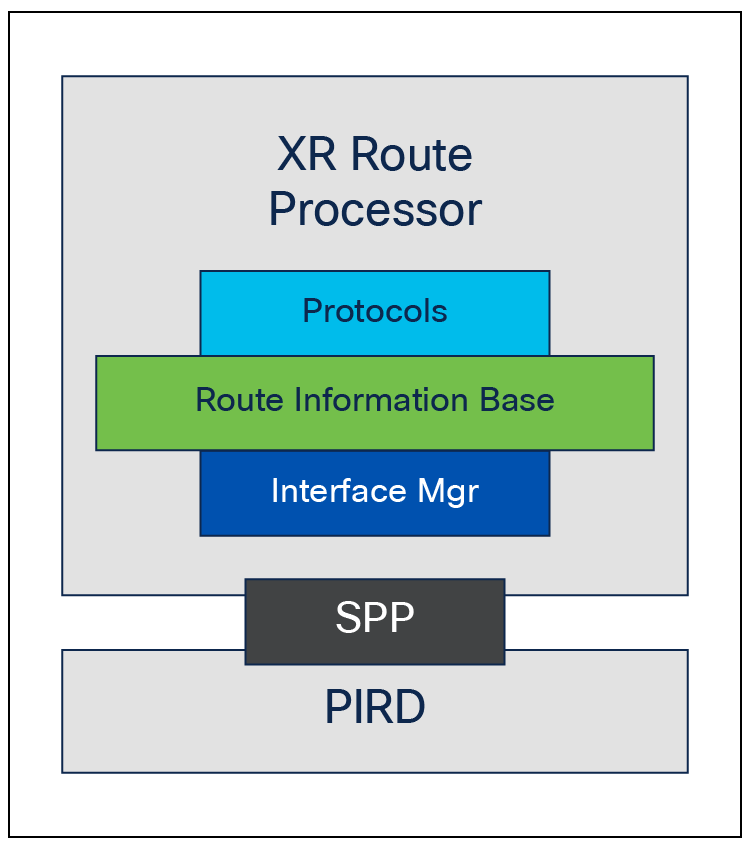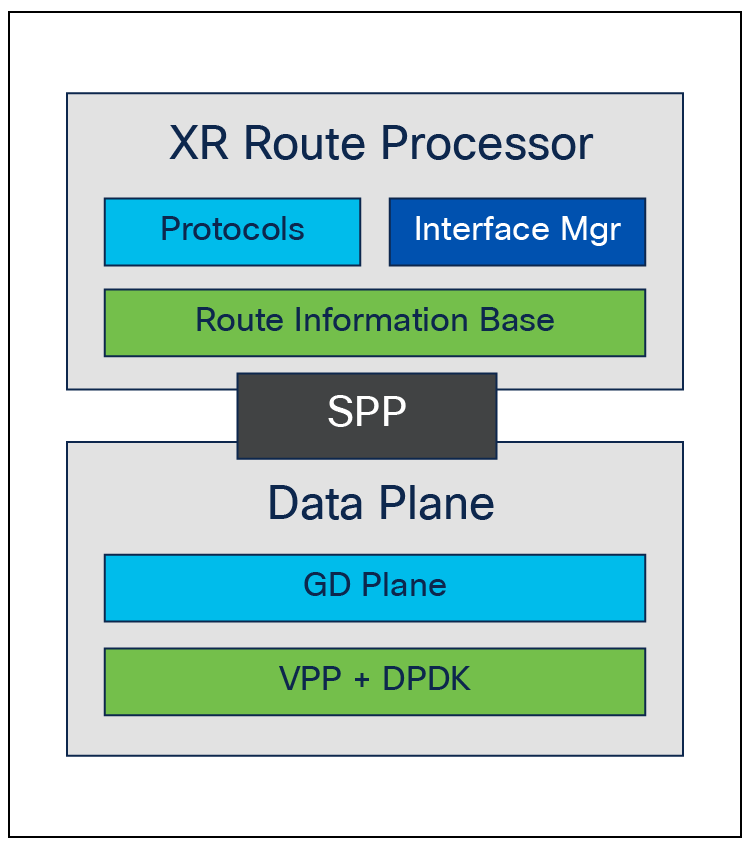Cisco IOS XRd Data Sheet
Available Languages
Bias-Free Language
The documentation set for this product strives to use bias-free language. For the purposes of this documentation set, bias-free is defined as language that does not imply discrimination based on age, disability, gender, racial identity, ethnic identity, sexual orientation, socioeconomic status, and intersectionality. Exceptions may be present in the documentation due to language that is hardcoded in the user interfaces of the product software, language used based on RFP documentation, or language that is used by a referenced third-party product. Learn more about how Cisco is using Inclusive Language.
The Cisco IOS® XRd implements the feature set of Cisco IOS XR Software in a Container. XRd complements existing physical Cisco® router platforms that rely on Cisco IOS XR Software, such as Cisco Network Convergence System Routers, Cisco ASR 9000 Series Routers, and Cisco 8000 Series Routers. Now, service providers can enhance their operational excellence and offerings based on XRd, by offering new services that needed routing functionality within a smaller footprint. With the advent of other network functions moving to public cloud, XRd provides the option to deploy the routing in a containerized form factor for routing between the network functions running on the cloud and the other functions running on-prem in the data centers as well. The Cisco IOS XRd offers greater agility, improved network efficiency, lower capital and operational expenditures, and the ability to efficiently scale up or down network capacity based on demand.
Main Features of the Cisco IOS XRd Router:
● Routing function that can run on a generic Kubernetes orchestration layer and allows the customers to manage the routing function similar to other applications running in the data center or cloud.
● Based on latest IOSXR7, XRd is lightweight, boots faster, and supports modern OS programmability features (YANG models – native and OC) and model-driven telemetry.
● XRd is derivative of extremely resilient, stable, and feature-rich Cisco IOS XR Software, and with the same northbound and management features as Cisco IOS XR Software, XRd integrates smoothly with existing monitoring, automation, and orchestration systems.
The Cisco IOS XRd can be deployed in the following two ways:

Cisco IOS XRd Control Plane
Cisco IOS XRd Control Plane: Cisco IOS XR Software is an industry-leading, carrier-class operating system supporting highly successful edge and core router platforms from Cisco. This modular OS provides a very high level of availability and its multiprocess and multithread architecture enhances scale and performance by taking advantage of modern multisocket and multicore processors. This supports the latest overlay routing stack of Segment Routing, which Cisco has been pioneering with. Cisco IOS XRd Control Plane is targeted for compute-heavy use cases like Virtual Route Reflector (vRR) and Path Compute Element (PCE). XRd Control Plane provides minimal forwarding capabilities, which is adequate for peering or southbound interfacing.

Cisco IOS XRd vRouter
Cisco IOS XRd vRouter (Control Plane + virtual forwarder): The virtual forwarder uses the feature and forwarding code developed for Cisco NPU-based physical platforms and the Intel® Data Plane Development Kit (DPDK). However, it is optimized specifically for general-purpose CPU environments. It uses Intel Streaming SIMD Extensions 2 (SSE2) and Advanced Vector Extensions (AVX) instructions for improved software-based classification. Memory access is asynchronous for parallel feature processing, and data structures are optimized for best utilization of the cache. In addition, batched packet delivery and processing and high-speed load balancing across the feature execution process help provide a very high-performance data plane, with the features service providers require. Cisco IOS XRd vRouter can be deployed with minimal footprint (~2 vCPUs) and is targeted for the use cases where there is a shortage of compute resources.
Table 1. Deployment model and benefits
| Feature |
Benefit |
| Traditionally a service provider deployed physical routing devices as route reflectors. A route reflector application makes intensive use of the Control Plane and is low on data plane usage. This leads to suboptimal usage of the capacity provided by the physical router. |
|
| Virtual route reflector |
● Convergence of many route reflectors into a few virtual route reflectors using Cisco IOS XRd
● Significant reduction of the physical footprint, power, cooling, and cabling overhead associated with maintaining physical route reflector systems
|
| Path Compute Element (PCE) is another compute-intensive function and warrants only minimal data plane capabilities, which doesn’t need a dedicated physical router for this functionality. This is offered under the Cisco Network Controller (CNC) umbrella and inherently will use the XRd in the PCE role. |
|
| Path Computation Element |
● Optimal utilization of the compute for the PCE functionality, which can run in centralized on-prem or public cloud, for managing the Segment Routing topology across the network
● Significant reduction of physical footprint, power, cooling, and cabling overhead associated with maintaining physical PCE systems
|
| With 5G deployments taking compute deployments to the Far Edge, XRd can be deployed along with Virtual Distributed Unit (vDU) on the compute, to route the mobile traffic toward the aggregation. |
|
| Virtual Cell Site Router |
● vDU is very compute intensive, and XRd fulfills the customer requirement to have the routing functionality on the same compute, consuming less CPU cores.
● For cell sites, where massive MIMO isn’t needed, XRd offers savings of OpEx and physical footprint by deploying a single RU COTS server at the mid-haul site.
|
| Service providers are partnering with hyperscalers to run the critical network functions as work loads on the public cloud, to attain CapEx savings and also embrace the agility and experience of the hyperscalers managing the virtualization at massive scale. XRd can be deployed as the routing gateway for the Network Functions running in the public cloud, enabling the overlay routing between the transport network and the NFs. |
|
| Cloud Router |
● Cisco XRd as a cloud router provides the overlay routing solution on public cloud environments, enabling the customers to continue to reuse the existing orchestration and assurance systems for the Network Functions deployed on the cloud, providing seamless XR experience.
|
| A service provider needs to provide Layer 3 Provider/Business Edge functionality at a location that has low throughput. They already have their service and offerings based on physical Cisco ASR 9000 or NCS devices and want to offer the same services at the low-throughput locations. Network-as-a-Service (NaaS) providers who offer scalable private connectivity for customers can utilize XRd for instantiating small form factor Edge routers at each of their POPs. |
|
| Virtual provider edge |
● Consistent architecture with widely used ASR 9000 and NCS Series platforms
● Rich set of networking experiences based on Cisco IOS XR Software
● Reduced Capital Expenditures (CapEx) and Operating Expenses (OpEx) realized by using simplified and consumption-based models
|
The Cisco IOS XRd offers a simplified subscription-based licensing scheme, based on:
● Per instance for the Control Plane
● Throughput utilization for the vRouter
The licensing structure allows service providers to pay for what they consume. Licenses are activated through Cisco Smart Software Licensing. Further details about Cisco Smart Software Licensing are available at www.cisco.com/c/en/us/products/abt_sw.html.
Table 2 lists specifications for the Cisco IOS XRd Router.
Table 2. Cisco IOS XRd specifications
| Parameter |
Requirement |
| XRd Control Plane Host |
|
| CPU |
x86-64 CPU with at least 2 cores |
| RAM |
4 GB |
| Linux kernel |
Version 4 and later Note: The Linux kernel must install the dummy and nf_tables modules. |
| Linux cgroups |
Version 1 Note: Support for unified hierarchy cgroups is not available. |
| XRd Control Plane instance |
|
| CPU |
1 core |
| RAM |
2 GB |
| inotify user instances and watches |
4000 |
| XRd Control Plane on AWS EC2 instance |
|
| Instance type |
m5.2xlarge |
| Number of threads per processor core |
1 |
| Minimum disk size |
8 GB Note: A XRd instance requires the minimum disk size of 8 GB, but there may be demand for additional disk space depending on how the node handles core files. |
| Operating system |
Amazon Linux 2 with EKS Optimizations |
| Kernel settings |
4000 inotify user instances and watches per XRd instance |
| XRd vRouter host |
|
| CPU |
x86-64 CPU with at least 4 cores |
| CPU instruction set |
● ssse3
● sse4.1
● sse4.2
|
| Linux kernel |
Version 4 and later Note: The Linux kernel must install the dummy and nf_tables modules. |
| Linux cgroups |
Version 1 Note: Support for unified hierarchy cgroups is not available. |
| Other modules required |
vfio-pci or ugb_io |
| XRd vRouter instance |
|
| CPU |
At least 2 isolated CPUs |
| RAM |
5 GB |
| Hugepages |
3 GB Note: The XRd vRouter instance must enable Hugepage support with 1GB hugepage size. |
| inotify user instances and watches |
4000 |
| XRd vRouter on Amazon EC2 Instance |
|
| Instance types |
● m5.24xlarge
● m5n.24xlarge
|
| Number of threads per processor core |
1 |
| Minimum disk size |
8 GB Note: An XRd instance requires the minimum disk size of 8 GB, but there may be demand for additional disk space depending on how the node handles core files. |
| Operating system |
Amazon Linux 2 with EKS Optimizations |
| Kernel settings |
● 4000 inotify user instances and watches per XRd instance
● CPU isolation settings for the required XRd deployments
|
| Additional kernel modules |
● uio (from Amazon Linux 2)
● igb_uio from DPDK 19.11.12, with write combine mode enabled
|
| Hugepages |
3 GB Note: The XRd vRouter instance must enable Hugepage support with 1GB hugepage size. |
Other Environments:
Table 3. Other supported environments
| Environment |
Description |
| Docker |
Docker version 18 or later with permission to run Docker containers |
| Vanilla Kubernetes |
1.22 |
Warranty information is available on Cisco.com at the Product Warranties page.
Flexible payment solutions to help you achieve your objectives
Cisco Capital makes it easier to get the right technology to achieve your objectives, enable business transformation and help you stay competitive. We can help you reduce the total cost of ownership, conserve capital, and accelerate growth. In more than 100 countries, our flexible payment solutions can help you acquire hardware, software, services and complementary third-party equipment in easy, predictable payments. Learn more.
www.cisco.com/c/en/us/products/ios-nx-os-software/ios-xr-software/index.html